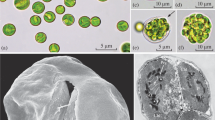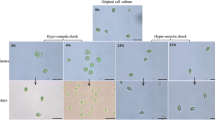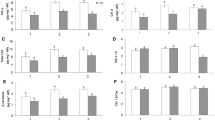Abstract
We employed chlorophyll a fluorometry in order to measure the evolution of turgor threshold (intracellular osmolality) during the adaptation of two genetic transformants of the freshwater cyanobacterium Synechococcus sp. PCC7942 to unfavorable external salinity: PAMCOD cells which oxidize imported choline and accumulate approx. 0.06–0.08 M glycine betaine; and PAM cells which do not oxidize choline [Deshnium et al. (1995a) Plant Mol Biol 29: 897–909]. Turgor thresholds increased linearly (a) with the NaCl concentration in the culture, and (b) with the molar sucrose/chlorophyll a ratio in the cell. PAMCOD cells could proliferate in culture medium containing 0.4 M NaCl (external osmolality, 0.815 Osm kg−1), after a lag period, during which intracellular sucrose rose to 10 mol (mol Chl a)−1, or more, and turgor threshold (cytoplasmic osmolality) exceeded 1 Osm kg−1. At comparative conditions, PAM cells accumulated approx. half as much sucrose, and attained approx. half as high turgor thresholds as the PAMCOD cells, but they did not proliferate. These results indicate that glycine betaine improved the salinity tolerance of the PAMCOD cells synergistically, by means of two effects that implicate sucrose, the main organic osmolyte of Synechocccus: enhancement of sucrose biosynthesis, and/or alleviation of sucrose toxicity.
Similar content being viewed by others
References
Allakhverdiev SI, Sakamoto A, Inaba M, Nishiyama Y and Murata N (2000) NaCl-induced inactivation of Photosytems I and II in Synechococcus: Contribution of K+/Na+, water channels and Na+/H+ antiporters. Plant Physiol 122: 1201-1208
Avigad GM (1990) Disaccharides. In: Dey PM (ed) Methods in Plant Biochemistry, Vol 2 Carbohydrates, pp 111-188. Academic Press, London
Blumwald E, Mehlhorn RJ and Packer L (1983a) Ionic osmoregulation during salt adaptation of the cyanobacterium Synechococcus 6311. Plant Physiol 73: 377-380
Blumwald E, Mehlhorn RJ and Packer L (1983b) Studies of osmoregulation in salt adaptation of cyanobacteria with ESR spin-probe techniques. Proc Natl Acad Sci USA 80: 2599-2602
Blumwald E, Wolosin JM and Packer L (1984) Na+/H+ exchange in the cyanobacterium Synechococcus 6311. Biochem Biophys Res Commun 122: 452-459
Csonka LN and Hanson AD (1991) Prokaryotic osmoregulation: Genetics and physiology. Annu Rev Microbiol 45: 569-606
Deshnium P, Los DA, Hayashi H, Mustardy L and Murata N (1995a) Transformation of Synechococcus with a gene for choline oxidase enhances tolerance to salt stress. Plant Mol Biol 29: 897-909
Deshnium P, Los DA, Hayashi H and Murata N (1995b) Glycinebetaine enhances tolerance to salt stress in transgenic cyanobacterium. In: Mathis P (ed) Photosynthesis from Light to Biosphere, Vol. IV, pp 637-640. Kluwer Academic Publishers, Dordrecht, The Netherlands
Dewar MA and Barber J (1973) Cation regulation in Anacystis nidulans. Planta 113: 143-155
Dworsky A, Myer B, Regelsberger G, Fromwald S and Peschek GA (1995) Functional and immunological characterization of both ‘mitochondria-like’ and ‘chloroplast-like’ electron/transport proteins in isolated and purified cyanobacterial membranes. Bioelectrochem Bioenerg 38: 35-43
Fry IV, Huflejt M, Erber WWA, Peschek GA and Packer L (1986) The role of respiration during adaptation of the freshwater cyanobacterium Synechococcus 6311 to salinity. Arch Biochem Biophys 244: 686-691
Grossman AR, Schaefer MR, Chiang GG and Collier JL (1995) The responses of cyanobacteria to environmental conditions: Light and nutrients. In: Bryant DA (ed) The Molecular Biology of Cyanobacteria, pp 641-675. Kluwer Academic Publishers, Dordrecht, The Netherlands
Imhoff JF and Rodriguez-Valera F (1984) Betaine is the main compatible solute of halophilic eubacteria J Bacteriol 160: 478-479
Khomutov G, Fry IV, Huflejt ME and Packer L (1990): Membrane lipid composition, fluidity and surface charge changes in response to growth of the fresh water cyanobacterium Synechococcus 6311 under high salinity. Arch Biochem Biophys 277: 263-267
Mackay MA, Norton RS and Borowitzka LJ (1984) Organic osmoregulatory solutes in cyanobacteria. J Gen Microbiol 130: 2177-2191
Mehlhorn RJ and Sullivan R (1988) Measurement of bioenergetics phenomena in cyanobacteria with magnetic resonance techniques. Meth Enzymol 169, 509-518
Molitor V, Erber W and Peschek GA (1986) Increased levels of cytochrome oxidase and sodium proton antiporter in the plasma membrane of Anacystis nidulans after growth in sodium-enriched media. FEBS Lett 204: 251-256.
Moran P (1982) Formulae for determination of chlorophyllous pigments extracted with N,N-dimethyl-formamide. Plant Physiol 69: 1376-1381
Murata N (1969) Control of excitation transfer in photosynthesis. I. Light-induced changes of chlorophyll a fluorescence in Porphyridium cruentum. Biochim Biophys Acta 172: 242-251
Nitschmann WH and Packer L (1992) NMR studies on Na+ transport in Synechococcus PCC 6311. Arch Biochem Biophys 294: 347-352
Nomura M, Ishitani M, Takabe T, Rai AK and Takabe T (1995) Synechococcus sp. PCC 7942 transformed with Escherichia coli genes produces glycine betaine from choline and acquires resistance to salt stress. Plant Physiol 107: 703-708
Paschinger H (1977) DCCD-induced sodium uptake by Anacystis nidulans. Arch Microbiol 113: 283-291
Papageorgiou GC (1996) The photosynthesis of cyanobacteria (blue-green bacteria) as probed by signal analysis of chlorophyll a fluorescence. J Sci Ind Res 55: 596-607
Papageorgiou GC and Alygizaki-Zorba A (1997) A sensitive method for the estimation of the cytoplasmic osmolality of cyanobacterial cells using chlorophyll a fluorescence. Biochim Biophys Acta 1335: 1-4
Papageorgiou GC and Govindjee (1967) Changes in intensity and spectral distribution of fluorescence: Effect of light treatment on normal and DCMU-poisoned Anacystis nidulans. Biophys J 7: 375-389
Papageorgiou GC and Murata N (1995) The unusually strong stabilizing effects of glycine betaine on the structure and function of the oxygen-evolving Photosytem II complex. Photosynthesis Res 44: 243-252
Papageorgiou GC, Alygizaki-Zorba A, Ladas N and Murata N (1998) A method to probe the cytoplasmic osmolality and water and solute fluxes across the cell membrane of cyanobacteria with chlorophyll a fluorescence: Experiments with Synechococcus sp. PCC 7942. Physiol Plant 102: 215-224
Reed RH, Borowitzka LJ, Mackay MA, Chudek JA, Foster R, Warr SRC, Moore DJ and Stewart WDP (1986) Organic solute accumulation in osmotically stressed cyanobacteria. FEMS Microbiol Rev 39: 51-56
Rippka R, Deruelles J, Waterbury JB, Herdman M and Stanier RT (1979) Generic assignments, strain histories and properties of pure cultures of cyanobacteria. J Gen Microbiol 111: 1-61
Ritchie RJ (1992) Sodium transport and the origin of membrane potential in the cyanobacterium Synechococcus R-2 (Anacystis nidulans) PCC 7942. J Plant Cell Physiol 139: 320-330
Stamatakis K and Papageorgiou GC (1999) Phycobilisome-to-Photosytem I excitation transfer is enhanced in water-depleted cells and depressed in water-replete cells of cyanobacterium Synechococcus sp. PCC 7942 In: Argyroudi-Akoyunoglou JH and Senger H (ed) The Chloroplast: From Molecular Biology to Biotechnology, pp 47-54. Kluwer Academic Publishers, Dordrecht, The Netherlands
Stamatakis K, Ladas NP, Alygizaki-Zorba A and Papagcorgiou GC (1999) Sodium choride-induced volume changes of freshwater cyanobacterium Synechococcus sp PCC 7942 cells can be probed by chlorophyll a fluorescence. Arch Biochem Biophys 370: 240-249
Whatmore AM and Reed RH (1990) Determination of turgor pressure in Bacillus subtilis: a possible role for K+ in turgor regulation. J Gen Microbiol 136: 2521-2526
Wolf AV, Brown MG and Prentiss PG (1983) Concentrative properties of aqueous solutions: Conversion trables. In: Handbook of Chemistry and Physics, 64th edn, pp D223-D272, Boca Raton, Florida
Author information
Authors and Affiliations
Corresponding author
Rights and permissions
About this article
Cite this article
Ladas, N.P., Papageorgiou, G.C. Cell turgor: A critical factor for the proliferation of cyanobacteria at unfavorable salinity. Photosynthesis Research 65, 155–164 (2000). https://doi.org/10.1023/A:1006423221150
Issue Date:
DOI: https://doi.org/10.1023/A:1006423221150




